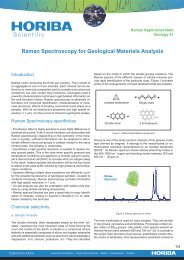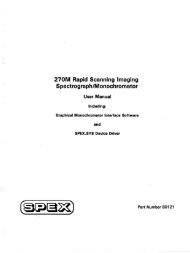Raman Spectroscopy - Art Application Note - Horiba
Raman Spectroscopy - Art Application Note - Horiba
Raman Spectroscopy - Art Application Note - Horiba
You also want an ePaper? Increase the reach of your titles
YUMPU automatically turns print PDFs into web optimized ePapers that Google loves.
faience and terra-cotta glazes and glasses, all<br />
types of low temperature processed silicates),<br />
and from left to right as function of the main flux.<br />
Figure 5: Plots of the polymerization index as a function<br />
of the main Si-O stretching component wavenumber<br />
However, Iznik and Kütahya wares and the<br />
history of their production remain a source of<br />
debate among scholars. The exact origin of<br />
“Iznik” products (Iznik, Damascus, Istanbul,<br />
Kütahya or elsewhere) is still an open question.<br />
As for Medici porcelains, wares (and shards)<br />
being very rare, they are not well documented<br />
and some fakes have been made for centuries.<br />
Some of the earlier fritwares are generally<br />
assigned to Iznik productions (blue and white<br />
wares sometimes classified as Touran, Roumi<br />
or Abraham of Kütahya style), but their<br />
production by Kütahya kilns was questioned.<br />
The real development of the production of<br />
Kütahya wares dates back to the end of the 17th century, following the emancipation of<br />
Byzantine and Armenian Christian communities.<br />
Furthermore, copies or fakes were made since<br />
the 19th century in different places.<br />
The same analysis and classification was thus<br />
performed on Iznik and Kütahya wares (Figure<br />
6). Some of the Kütahya glazes can be<br />
associated to family 7 (PbO-rich glass) but<br />
some of them are also located in the Iznik<br />
group (e.g. sample 7460). On the other hand,<br />
Iznik glazes are all located in between family 5<br />
(Na2O + PbO) and family 4 (Na2O-rich silicates)<br />
<strong>Art</strong> 02<br />
except for two types of glazes located in family<br />
7 (PbO-rich) and in family 2 (CaO-rich).<br />
The <strong>Raman</strong> signature of the Iznik production<br />
thus appears to be fairly homogeneous. This is<br />
due to the fact that Iznik manufacturers were<br />
controlled by the nakkashane, the Ottoman<br />
office for décor and drawing. By contrast, the<br />
significant variation in the <strong>Raman</strong> signature of<br />
the Kütahya glazes reflects the autonomy of<br />
different production centers working according<br />
to the Kütahya style. Furthermore, the<br />
procedure was also efficient to discriminate<br />
between early and late Iznik production, based<br />
on a small compositional shift of the silicate<br />
glaze at the decline of the production (17th<br />
century) [8].<br />
Figure 6: Bi-plot of the polymerization index (Ip) as a<br />
function of the Si-O stretching wavenumber maximum for<br />
the series of Iznik and Kütahya fritware glazes. Sample<br />
label: Curator' assignment (Iz, Iznik; Ku, Kütahya), color<br />
(b: blue, r : red, …), artifact record number.<br />
The two parameters Ip and νmax, thus appear to<br />
be good tools for classification, and<br />
differentiation between Kütahya and Iznik<br />
Ottoman pottery is relatively straightforward<br />
from the <strong>Raman</strong> fingerprint [7,8].<br />
Analysis of the colorless/white regions of the<br />
samples always reveals the more or less strong<br />
<strong>Raman</strong> signature of α-quartz (Figure 7). By<br />
modifying the focal point of the laser with the<br />
XYZ plate it is possible to confirm that the white<br />
color is obtained by an α-quartz-rich slip<br />
3/4
















